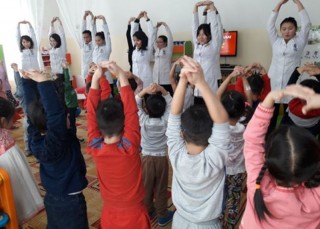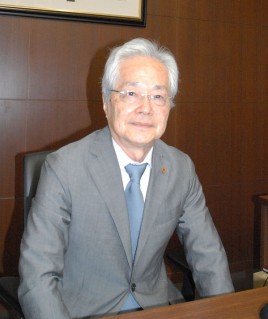▼ Specialist Develops New Respiratory Exercise That Gives Mind a Breather
- Category:Other
A breathing exercise developed by respiratory specialist Ikuo Homma, who has long studied the close relationship between breathing and emotion, has attracted attention as a simple but effective way to build a healthy body and mind and ultimately improve the quality of people’s lives.
Calm Breathing Project, a nonprofit organization based in Tokyo, has promoted the Ratata breathing exercise, in which simple body movements of the neck, shoulders and chest are brought in line with one’s breathing rhythm, in areas stricken by the 2011 Great East Japan Earthquake. It has also been used in places including nursing care facilities across the nation.
“Difficulty in breathing is tantamount to difficulty living,” Homma, 70, director of the NPO, said during a recent interview with The Japan News. “If you change the way you breathe, you can calm down your mind, and the state of your body will improve as breathing and emotion move in tandem.”
The NPO was launched in 2013 to provide psychological support to people, particularly children, in the disaster-hit Tohoku region through breathing. Homma said conventional psychotherapeutic techniques such as cognitive-behavioral therapy generally involve flashbacks of agonizing experiences, making many people shy away from such methods.
“We simply aimed to change the way they breathe without thinking much about specific psychotherapeutic methods,” he said.
Homma picked the name Ratata from the nickname of a popular motorcycle released in the 1970s. The exercise is conducted to cheerful music, whose lyrics were written by Homma himself, using catchy words for children.
“When the music is played, you can move and breathe naturally,” he said. “It’s essential to keep doing it. The exercise is simple, but you won’t be able to continue unless you understand how it works.”
Approach backed scientifically
Homma, who is also president of Tokyo Ariake University of Medical and Health Sciences, has proposed from a scientific point of view that such a breathing approach be taken in disaster-hit areas worldwide. With his study focusing on what he calls “emotional breathing,” the respiratory physiologist said that respiration is closely connected to emotion.
Anxiety and anger tend to make breathing rapid and shallow, while breathing is likely to become slow and deep when people feel relaxed. He said many people have experienced this relationship firsthand, but scientific research on the topic is relatively new.
His research has found that respiration is closely attuned to activity in the amygdala — the emotional center of the brain. He said many people in contemporary society have problems with this type of breathing due to stress. But based on this mechanism, stress can be eased through breathing. “By controlling your breathing, you can control your emotions,” he said.
Calm Breathing Project, a nonprofit organization based in Tokyo, has promoted the Ratata breathing exercise, in which simple body movements of the neck, shoulders and chest are brought in line with one’s breathing rhythm, in areas stricken by the 2011 Great East Japan Earthquake. It has also been used in places including nursing care facilities across the nation.
“Difficulty in breathing is tantamount to difficulty living,” Homma, 70, director of the NPO, said during a recent interview with The Japan News. “If you change the way you breathe, you can calm down your mind, and the state of your body will improve as breathing and emotion move in tandem.”
The NPO was launched in 2013 to provide psychological support to people, particularly children, in the disaster-hit Tohoku region through breathing. Homma said conventional psychotherapeutic techniques such as cognitive-behavioral therapy generally involve flashbacks of agonizing experiences, making many people shy away from such methods.
“We simply aimed to change the way they breathe without thinking much about specific psychotherapeutic methods,” he said.
Homma picked the name Ratata from the nickname of a popular motorcycle released in the 1970s. The exercise is conducted to cheerful music, whose lyrics were written by Homma himself, using catchy words for children.
“When the music is played, you can move and breathe naturally,” he said. “It’s essential to keep doing it. The exercise is simple, but you won’t be able to continue unless you understand how it works.”
Approach backed scientifically
Homma, who is also president of Tokyo Ariake University of Medical and Health Sciences, has proposed from a scientific point of view that such a breathing approach be taken in disaster-hit areas worldwide. With his study focusing on what he calls “emotional breathing,” the respiratory physiologist said that respiration is closely connected to emotion.
Anxiety and anger tend to make breathing rapid and shallow, while breathing is likely to become slow and deep when people feel relaxed. He said many people have experienced this relationship firsthand, but scientific research on the topic is relatively new.
His research has found that respiration is closely attuned to activity in the amygdala — the emotional center of the brain. He said many people in contemporary society have problems with this type of breathing due to stress. But based on this mechanism, stress can be eased through breathing. “By controlling your breathing, you can control your emotions,” he said.
The NPO has expanded its activities with a new focus on elderly people whose respiratory functions have deteriorated, a symptom of aging that tends to affect their minds.
When the NPO conducted the exercise once a week for six months with people at an average age of 80 at a day-care facility in Kyoto, improvement was seen in their breathing capacity. The participants also reported less anxiety and more stable moods, among other psychological effects.
“It doesn’t cost anything at all. Japan can no longer spend much money on social welfare, a breathing exercise like this could help people prolong their health-life span,” Homma said.
Growing attention in Mongolia
His breathing initiative also has gained attention in Mongolia, where his university has a sister school. Homma originally created the breathing exercise for people with respiratory diseases such as asthma when industrial pollution became a social issue in Japan decades ago.
In Ulaanbaatar, the rapidly growing Mongolian capital plagued by air pollution, the exercise has been introduced at places such as elementary schools and an orphanage, receiving TV coverage in March. With the prevalence of childhood asthma increasing in the country, the exercise is now planned to be introduced at more than 200 kindergartens in Ulaanbaatar from the new academic year in September, according to a Mongolian doctor involved in the project.
“After practicing clinical medicine, I chose to become a researcher to help more people. So my activities place importance on serving people well,” Homma said.
When the NPO conducted the exercise once a week for six months with people at an average age of 80 at a day-care facility in Kyoto, improvement was seen in their breathing capacity. The participants also reported less anxiety and more stable moods, among other psychological effects.
“It doesn’t cost anything at all. Japan can no longer spend much money on social welfare, a breathing exercise like this could help people prolong their health-life span,” Homma said.
Growing attention in Mongolia
His breathing initiative also has gained attention in Mongolia, where his university has a sister school. Homma originally created the breathing exercise for people with respiratory diseases such as asthma when industrial pollution became a social issue in Japan decades ago.
In Ulaanbaatar, the rapidly growing Mongolian capital plagued by air pollution, the exercise has been introduced at places such as elementary schools and an orphanage, receiving TV coverage in March. With the prevalence of childhood asthma increasing in the country, the exercise is now planned to be introduced at more than 200 kindergartens in Ulaanbaatar from the new academic year in September, according to a Mongolian doctor involved in the project.
“After practicing clinical medicine, I chose to become a researcher to help more people. So my activities place importance on serving people well,” Homma said.
- May 7, 2018
- Comment (989)
- Trackback(0)
Comment(s) Write comment
canada online pharmacies <a href="http://canadianphrmacy23.com/">CanadianPharmacyOnlineToUsa.com Canadian Pharmacy Online</a>
canadapharmacyonline.com [url=http://canadianphrmacy23.com/]canadian pharmacies without prescriptions[/url]
canadapharmacyonline.com [url=http://canadianphrmacy23.com/]canadian pharmacies without prescriptions[/url]
-
p1epo2oi2 Web Site
- February 28, 2024
canadian pharmacy online <a href="http://canadianphrmacy23.com/">internet pharmacy</a>
canadian pharmacy.reviews [url=http://canadianphrmacy23.com/]at Bing[/url]
canadian pharmacy.reviews [url=http://canadianphrmacy23.com/]at Bing[/url]
-
8coa8eaq1 Web Site
- February 28, 2024
canadian pharmaceutical <a href="http://canadianphrmacy23.com/">Canadian Pharmacies Online</a>
canadian pharmacy - viagra [url=http://canadianphrmacy23.com/]recommended you read[/url]
canadian pharmacy - viagra [url=http://canadianphrmacy23.com/]recommended you read[/url]
-
k903uk2wm Web Site
- February 27, 2024
canadian pharmacy-viagra <a href="http://canadianphrmacy23.com/">cialis canada pharmacy</a>
generic cialis online pharmacy [url=http://canadianphrmacy23.com/]canadianphrmacy23.com[/url]
generic cialis online pharmacy [url=http://canadianphrmacy23.com/]canadianphrmacy23.com[/url]
-
in3561u20 Web Site
- February 27, 2024
the canadian pharmacy <a href="http://canadianphrmacy23.com/">Canadian Pharmacy Online canadianphrmacy23.com</a>
cialis in usa pharmacy [url=http://canadianphrmacy23.com/]Canadian Pharmacy Online canadianphrmacy23.com[/url]
cialis in usa pharmacy [url=http://canadianphrmacy23.com/]Canadian Pharmacy Online canadianphrmacy23.com[/url]
-
1a2zrhpdo Web Site
- February 27, 2024
canada pharmacy cialis <a href="http://canadianphrmacy23.com/">Northwest Pharmacy In Canada</a>
generic cialis canada pharmacy online [url=http://canadianphrmacy23.com/]click[/url]
generic cialis canada pharmacy online [url=http://canadianphrmacy23.com/]click[/url]
-
c18fipwlg Web Site
- February 27, 2024
cialis usa pharmacy <a href="http://canadianphrmacy23.com/">Canadian Pharmacy Shipping Usa Cialis, Viagra Whithout Prescription</a>
canadian pharmacy no prescription [url=http://canadianphrmacy23.com/]canadian pharmacy-viagra[/url]
canadian pharmacy no prescription [url=http://canadianphrmacy23.com/]canadian pharmacy-viagra[/url]
-
8ho0gsuf3 Web Site
- February 26, 2024
best canadian pharmacies shipping to usa <a href="http://canadianphrmacy23.com/">Online Pharmacies</a>
cialis canada online pharmacy [url=http://canadianphrmacy23.com/]london pharmacy canada[/url]
cialis canada online pharmacy [url=http://canadianphrmacy23.com/]london pharmacy canada[/url]
-
huuwidbv7 Web Site
- February 26, 2024
viagra from a pharmacy in canada <a href="http://canadianphrmacy23.com/">canadian pharmacy canadianphrmacy23.com</a>
canadian pharmacy viagra [url=http://canadianphrmacy23.com/]northwest pharmacy in canada[/url]
canadian pharmacy viagra [url=http://canadianphrmacy23.com/]northwest pharmacy in canada[/url]
-
lyss9bp9w Web Site
- February 26, 2024
www.canadianpharmacymeds.com <a href="http://canadianphrmacy23.com/">pharmacy viagra</a>
approved canadian online pharmacies [url=http://canadianphrmacy23.com/]Canadian Pharmacy Shipping Usa[/url]
approved canadian online pharmacies [url=http://canadianphrmacy23.com/]Canadian Pharmacy Shipping Usa[/url]
-
9ib6ob22z Web Site
- February 26, 2024
canadian pharmacy store <a href="http://canadianphrmacy23.com/">useful link</a>
us pharmacy cialis [url=http://canadianphrmacy23.com/]canadian online pharmacies[/url]
us pharmacy cialis [url=http://canadianphrmacy23.com/]canadian online pharmacies[/url]
-
qm55uaxva Web Site
- February 25, 2024
pharmacy viagra <a href="http://canadianphrmacy23.com/">Pharmacy</a>
viagra from canada pharmacy [url=http://canadianphrmacy23.com/]canadian pharmacies online canadianphrmacy23.com[/url]
viagra from canada pharmacy [url=http://canadianphrmacy23.com/]canadian pharmacies online canadianphrmacy23.com[/url]
-
4b81stjl9 Web Site
- February 25, 2024
canada pharmacies <a href="http://canadianphrmacy23.com/">northwest pharmacy canada</a>
online pharmacies in canada [url=http://canadianphrmacy23.com/]Pharmacy[/url]
online pharmacies in canada [url=http://canadianphrmacy23.com/]Pharmacy[/url]
-
aq5b1kqip Web Site
- February 25, 2024
canadian discount pharmacies <a href="http://canadianphrmacy23.com/">see post</a>
cialis canadian pharmacy [url=http://canadianphrmacy23.com/]canadian online pharmacies[/url]
cialis canadian pharmacy [url=http://canadianphrmacy23.com/]canadian online pharmacies[/url]
-
vhn899yz5 Web Site
- February 25, 2024




Мы предлагаем: <a href=https://remont-byttekhniki-moskva.ru>ремонт крупногабаритной техники в москве</a>
Наши мастера оперативно устранят неисправности вашего устройства в сервисе или с выездом на дом!
сервис центры в москве Web Site- September 9, 2024